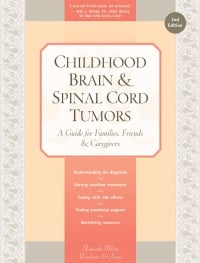Childhood Brain and Spinal Cord Tumors
Dying at home
A child’s death at home and the time just before can be a peaceful experience, depending on the extent of preparation and the quality of support available to the family. Unlike other childhood cancers, pain and its control are rarely associated with brain and spinal cord tumors, although families should keep their doctor or hospice team apprised if their child is experiencing any discomfort. For this reason, many families of children with brain and spinal cord tumors choose for their children to die at home.
Four weeks before Stacia died, she called us into her room. One by one, she proclaimed her love for each of us, and thanked us for being the best family a girl could ever have. She told us not to worry, that she was going to be all right, and that one day, we would all be together again. On Memorial Day, Stacia died in her mother Linda’s arms, with all of us at her side.

Just before Thanksgiving, 10 days before Jay’s 15th birthday, my worst fear was realized—the tumor was back, an anaplastic ependymoma, and this time, in the brainstem. Because of location, surgery was not possible. And this time, radiation wasn’t possible either. We faced the decision of attempting an aggressive and not usually very successful chemotherapy or calling it quits and letting him go. Choosing hospice was the hardest decision of our lives.
Jay wanted to die at home, it was important to him. Toward the end, we sat near Jay’s bed talking softly. A few minutes later, I leaned over to check on our son. He seemed to be slipping away.
“Squeeze my finger if you can hear me,” I pleaded. Jay gave my finger a light squeeze, so weightless I could barely feel it. He slept in a classic fetal position, knees beneath his chest, occupying as small a space as possible. A few minutes later, I spoke to him again, this time no response. Gently, I grasped his wrist with my thumb and forefinger and counted a pulse. We called hospice and they offered to send a nurse over, but we refused, preferring to receive their support by telephone.
We sat at Jay’s bedside. At 9:00, our daughter Vanessa came home. She spoke to her brother, his eyebrows arched, but he didn’t respond in any other way. We felt positive he could hear her. At first, I thought I must have given my son too much morphine. Gary called the doctor and the doctor insisted that I hadn’t. Deep down I knew I hadn’t done anything wrong. There wasn’t anything I could have done differently to help my son become fully alert again.
Throughout the night, we all stayed with Jay. We folded ourselves onto the bed with him, surrounding him. In the center, Jay lay between the three of us, small, quiet, immobile, with his dog at his side. All night, his breathing stopped and then started again.
“Maybe we need to tell him that it’s okay to die,” Vanessa offered. “Jay, I love you,” she said. “Don’t worry, I’ll do your chores and help Mom. Time is different in heaven; we’ll be there with you before you know it,” she cooed.
I kissed Jay on his forehead. “It’s okay,” I whispered. “Don’t wait for anything, it’s time for you to go.” At that moment, Jay smiled the sweetest smile, and a peaceful feeling as wide as the sky settled over us, something warm and cozy fell across my heart, and then he was gone.
Table of Contents
All Guides- Introduction
- 1. Diagnosis
- 2. The Brain and Spinal Cord
- 3. Types of Tumors
- 4. Telling Your Child and Others
- 5. Choosing a Treatment
- 6. Coping with Procedures
- 7. Forming a Partnership with the Treatment Team
- 8. Hospitalization
- 9. Venous Catheters
- 10. Surgery
- 11. Chemotherapy
- 12. Common Side Effects of Chemotherapy
- 13. Radiation Therapy
- 14. Peripheral Blood Stem Cell Transplantation
- 15. Siblings
- 16. Family and Friends
- 17. Communication and Behavior
- 18. School
- 19. Sources of Support
- 20. Nutrition
- 21. Medical and Financial Record-keeping
- 22. End of Treatment and Beyond
- 23. Recurrence
- 24. Death and Bereavement
- 25. Looking Forward
- Appendix A. Blood Tests and What They Mean
- Appendix C. Books and Websites

